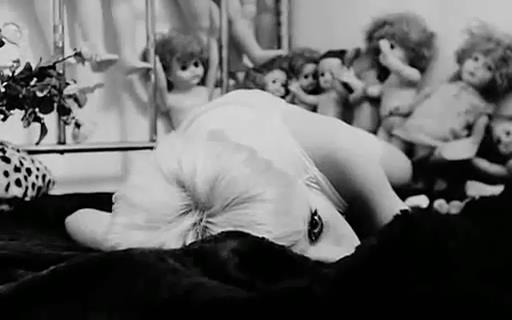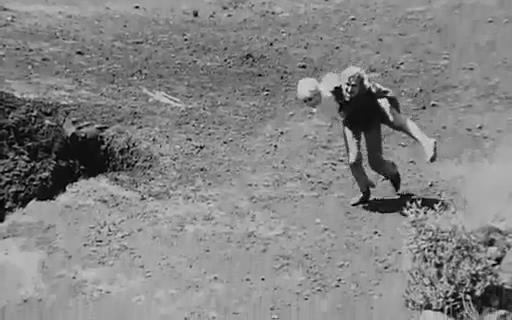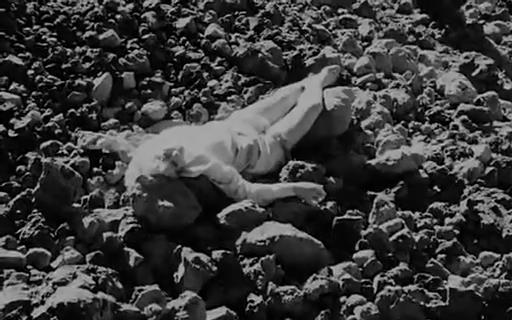La Cravate
Two
reels, color. Chaplin via
Marceau. Silent, music by
Edgar Bischoff.
The man who lost
his head over a girl and could not find it anywhere, a girl takes it home for
the mantelpiece, under a bell jar it goes at night.
The other half lives
and works the eventual conjunction, with a warning against overmuch politesse, the
title article is strictly to be worn ailleurs.
Co-directed
with (“réalisé par”) Saul Gilbert and Ruth Michelly.
Fando y Lis

“Another
rose, Mr. Pound?”
“Once
upon a time, a very long time ago, there was a wondrous city called Tar. At
that time all the cities were intact and flourishing because the final war had
not yet begun, when the great catastrophe occurred all
the cities crumbled, except Tar.
“Tar
exists today, if you know where to look for it you will find it and when you
get there you’ll be presented with wine and water and play a wind-up music box,
when you come to Tar you will help harvest grapes and pick up scorpions hidden
under white rocks, when you come to Tar you’ll know eternity, you'll see a bird
that drinks one drop of water from the ocean every hundred years, when you come
to Tar you will understand life and become a cat and a phoenix and a swan and
an elephant and a baby and an old man, you'll be alone and in company, love and
be loved, sharing the same space, and yours will be the seal of seals, as you
approach the future you'll find ecstasy, it will overwhelm you and never
abandon you.”
A
poem of a play by Arrabal, a riot in Acapulco like The Playboy of the Western World in
Dublin (the material goes to a surprising degree into Jodorowsky’s
unfilmed Dune).

Canto Primero. Herostratus (dir. Don Levy), The
Bed Sitting Room (dir. Richard Lester), William Klein, Pete Walker, the
flaming piano is a legacy of Buñuel (Un Chien Andalou) by way of
Dali, the graveyard fantasy is contemporaneous with Bye Bye Braverman
(dir. Sidney Lumet)...
“The
tree took refuge in a leaf, the house in a door, the city in a house.”
Canto Segundo, not so very far from Werner Herzog. The “labyrinth” outside the city
is contemporaneous with Barbarella (dir.
Roger Vadim), e Fando
è il mondo, prehistoric
landscape, shrouded figure antedating Mahler
(dir. Ken Russell), Hour of the Wolf
(dir. Ingmar Bergman), women with balls and whips (cf. Godard’s Alphaville)
not so very far from Russ Meyer, Fellini out of Kafka, Black Moon (dir. Louis Malle)...
Canto Tercero. Goats and drag queens (they dress
Fando as Lis and Lis as Fando), La Chinoise
(dir. Jean-Luc Godard) or Dziga Vertov
Group agitprop (no slogans, just their names, like the dinner duel in Charlie Bubbles, dir. Albert Finney), a
blind beggarly bloodsucker and the father of it (shades of El Ataúd del Vampiro,
dir. Fernando Mendez, Fando tries it), next as they say in burlesque the mother
of us all (cf. Richardson’s The Loved One and Ferreri’s
La Grande bouffe),
father and the firing squad, not so very far from John Waters...
Canto Cuarto. Memories of the mountebanks (cf. Hitchcock’s Marnie and Preminger’s The
Man with the Golden Arm), a Gadarene litter, the
bait and the buzzards, Woman in the Dunes
(dir. Hiroshi Teshigahara), “the stone of madness” (cf. Kershner), the broken handcuffs (esposas), the
broken drum, La Strada
(dir. Federico Fellini), cf.
Russell’s Tommy...
Roger Greenspun of the New York Times, “unpleasant whimsy.” Michael Atkinson (Village Voice), “adorable, preposterous”.
Film4, “lyrical fantasy”.
Solomon
on wisdom as “the principal thing,” cf.
Losey’s La Truite.

El Topo
A great work of the cinema, almost beyond all others.
Like Kubrick’s 2001: A Space Odyssey, a tale of the
Old and New Testaments.
That
said, and that is all, one really must regard the critics as a queer culture
phenomenon.
Boulez’
tunnel, eventually.
The Holy Mountain
The
Temptation of Christ (you will recognize the tower of Simon Magus from Victor Saville’s The Silver Chalice).
Christ, that
thief in the night, sustains this burlesque farrago of semi-mystical and
mystical inundations because, like you, he is mortal, likewise immortal, and
can take it.
Much wisdom
derives from the adventure, be assured, or wherein would lie the temptation?
A most brilliant
improvisation upon the theme of enlightenment, what else should Satan be after? It is all so very seeming, and logical.
Jodorowsky only drops the joke in the theater, one and all
are told on the mountainside it’s only a show.
Buñuel hardly
labored in the Mexican vineyards for nothing, pace the critics.
Jodorowsky’s next project, “the most important picture in the
story of humanity,” was reassigned to David Lynch.
Tusk
Une fable panique
The
magnificent opening shot uses a slow pan and a zoom lens to convey in a
continuous motion the village waking and its elephants setting out to the day’s
work.
The
simultaneous birth of an English baby girl named Elise and a baby elephant
named Ganesh but called by the English with the title
of this film is highly auspicious or, as film critics say, portentous.
The
vision of India is replete to the point of epiphany (Krishna among the villagers), Renoir’s The River
is relied upon for this a good deal, again auspiciously.
Something deadly in the land, philistine traders,
portentous... deadly comical in the vein of Satyajit Ray.
This
is extraordinarily well-situated to address Lean’s A Passage to India in a sort of mirror fashion. The quality of
panic fear adduced is a feature of the better-known work as well, of course,
famously. Quite a panic fable on a traitress
to the Raj.
TV Guide, “confusing, pseudo-art film”. Eleanor Mannikka
(Rovi), “ultimately unpalatable”.
The
Maharajah’s cotton candy shipped in from Las Vegas and kept under a bell jar
from the heat is by way of La Cravate, to be sure.
The
latter half begins as magisterially as the first after the manner of antiphony
with the Maharajah of Mysore setting out in grand
array for the royal hunt. Jodorowsky recapitulates
the opening shot in the course of this sequence, a secondary and more literal
echo of the theme, as it were.
Cp.
Tarzan Goes to India (dir. John
Guillermin). The prodigies of the filming are part and parcel of the style. Samadhi the mahout, Ram Baba, “what is that? Strange, it
smells like monkey shit.”
“It
is monkey shit.” There is
Guillermin’s Sheena as well, which is
to say the bee-stung bull of Mark Twain’s Joan.
It
ends in yet another epiphany, cp. The Elephant God, dir. Satyajit Ray.
Santa Sangre
As
they say in Casablanca, “qu’un sang impur abreuve nos
sillons!”
Postmodernism,
in a word. It means arms for
the Venus de Milo, maybe even another limb.
There is not a
director anywhere who even approaches this level of genius, and there is Jim
O’Connolly (Berserk), not to mention John Sturges (The Capture).
The Rainbow Thief
“Lovers
of call girls are fat and sassy,” says Baudelaire’s Icarus,
who leaves no name. Their dogs eat like princes (cf. Conway’s A Tale of Two
Cities), a prince goes out from amongst them to
live in a sewer, where he contrives to attain enlightenment and is tended by a
beggarly thief in expectation of an inheritance.
The setting is a
Europe of old with a flair for the Thirties of Vidor and Capra and Borzage (Man’s
Castle), which is the source of Brooks’ Life Stinks.
The Rainbow Girls
get the money to care for the dogs, the prince is
flooded out to sea, a blessing yet appears unto the lowly thief.
A
film reportedly without distribution, like John Frankenheimer’s Impossible Object.